A fuzzy expert system based on positive rules for depression diagnoisis
Fuzzy set theory and fuzzy logic are highly suitable mathematical tools for
developing intelligent systems in medicine. This paper presents a fuzzy expert system
based on positive rules for diagnosing depression types. A knowledge base that includes
more than 800 positive rules to determine diagnostic conclusions for 04 types of
depression. The expert system has been tested on more than 200 medical records of
depressed patients. Test results show the suitable accuracy of the system in diagnosis.
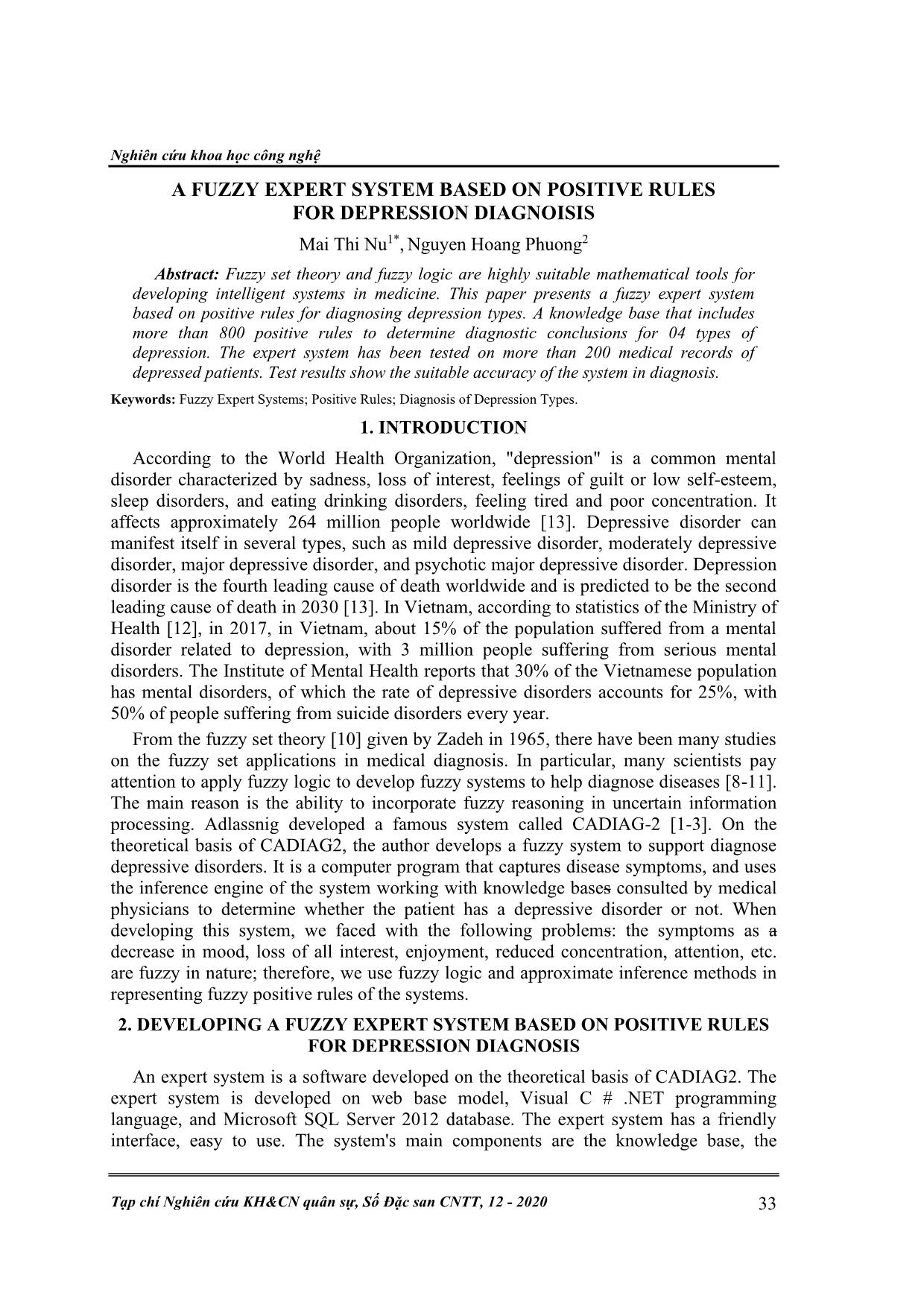
Trang 1
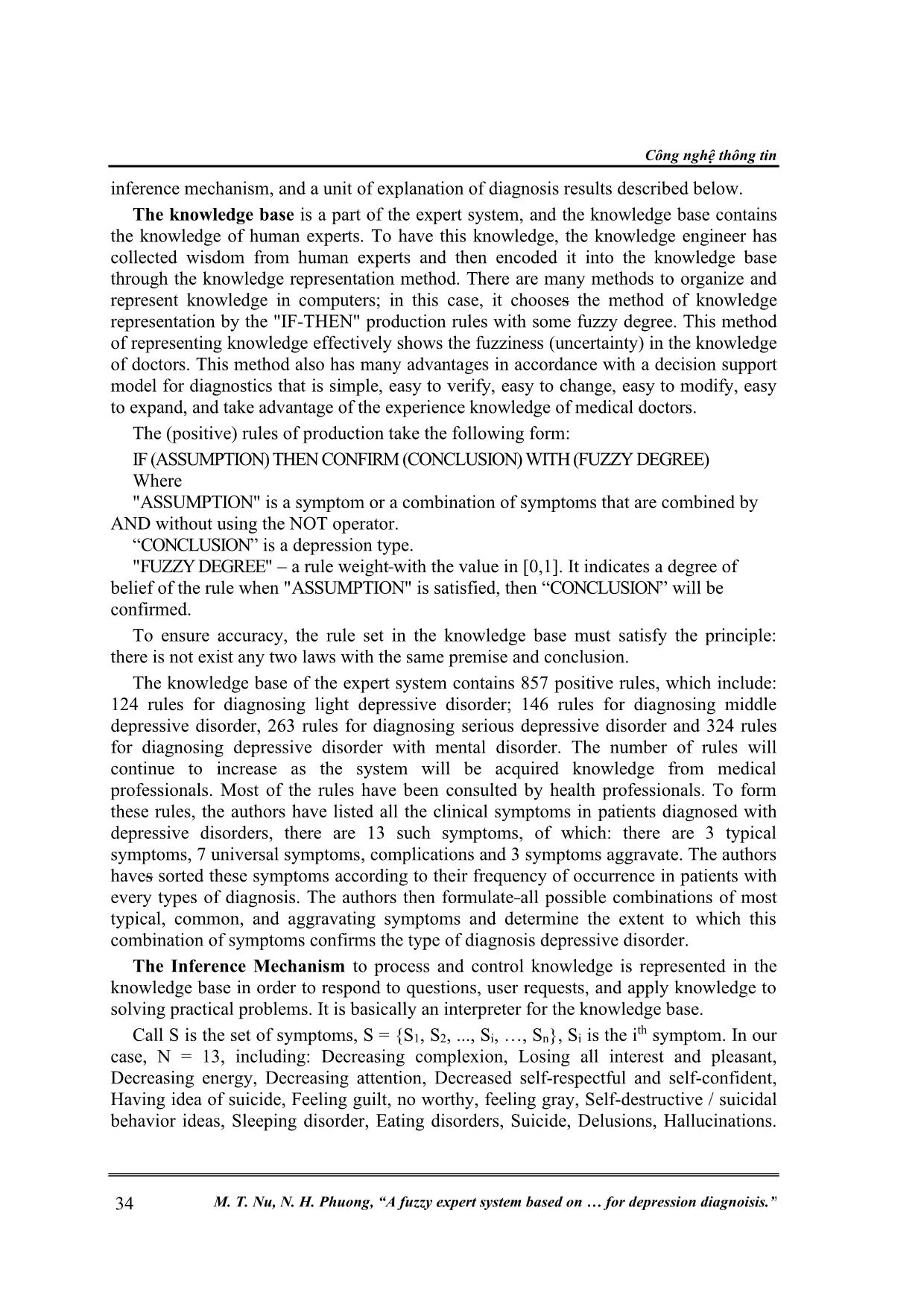
Trang 2
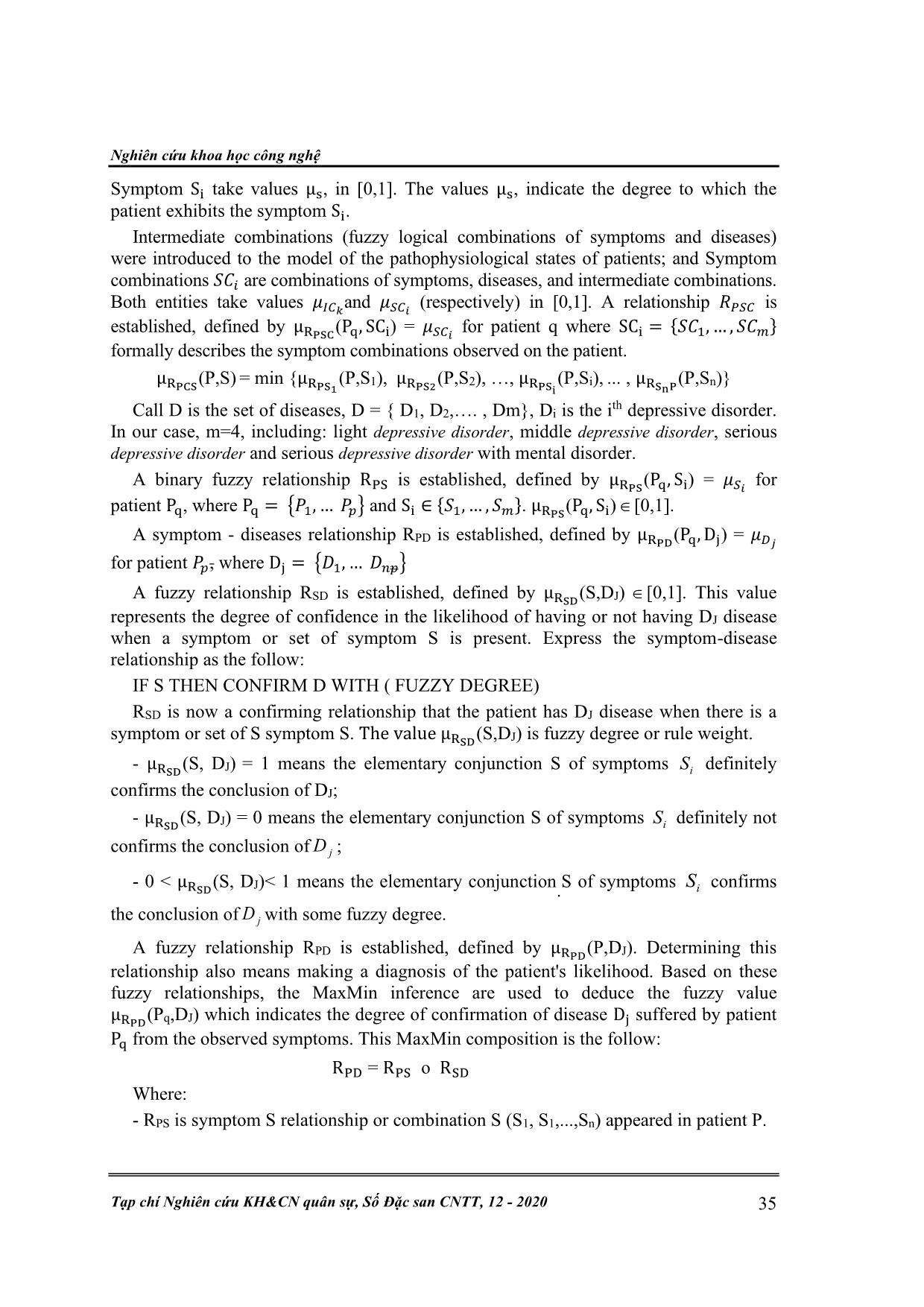
Trang 3
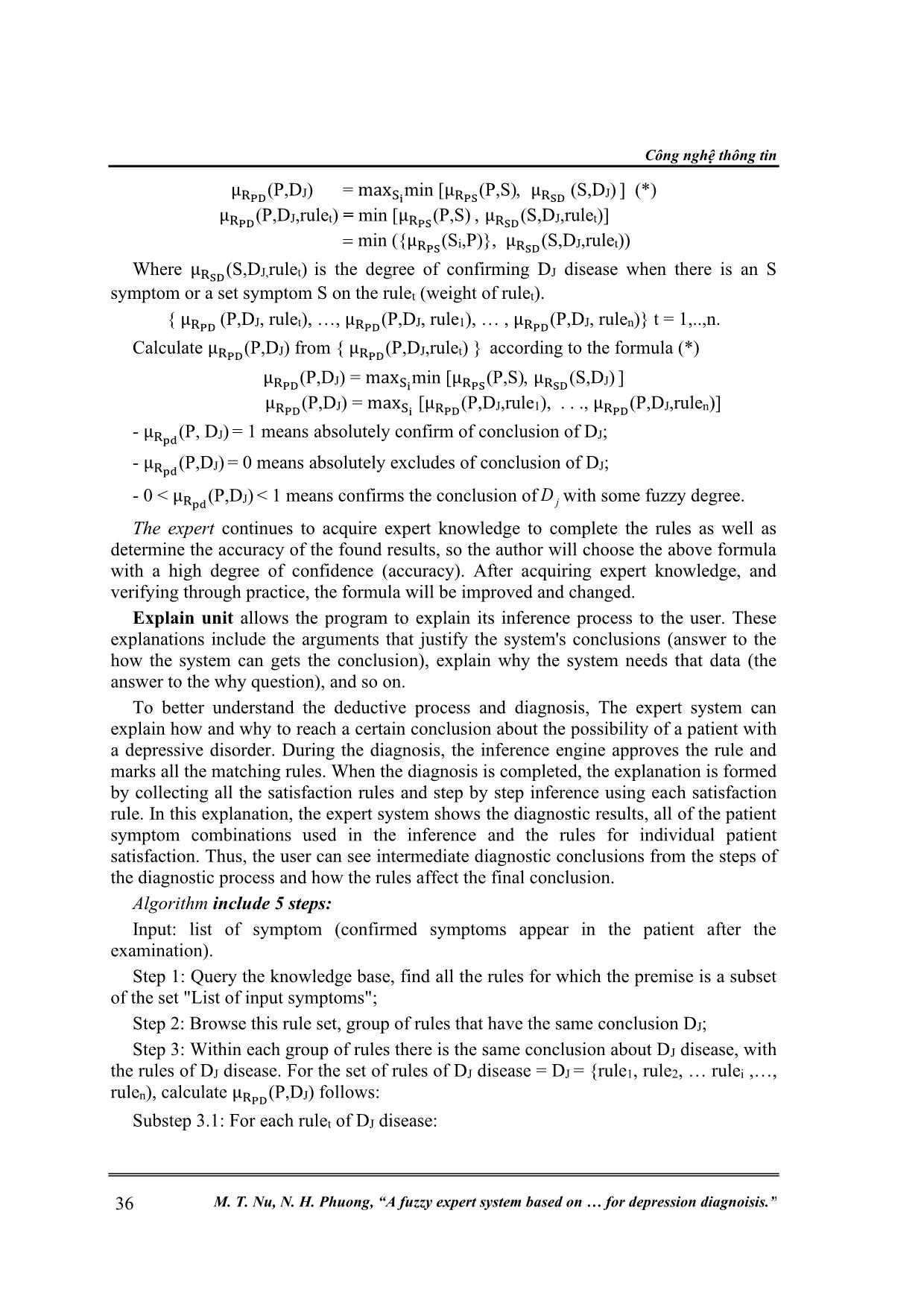
Trang 4
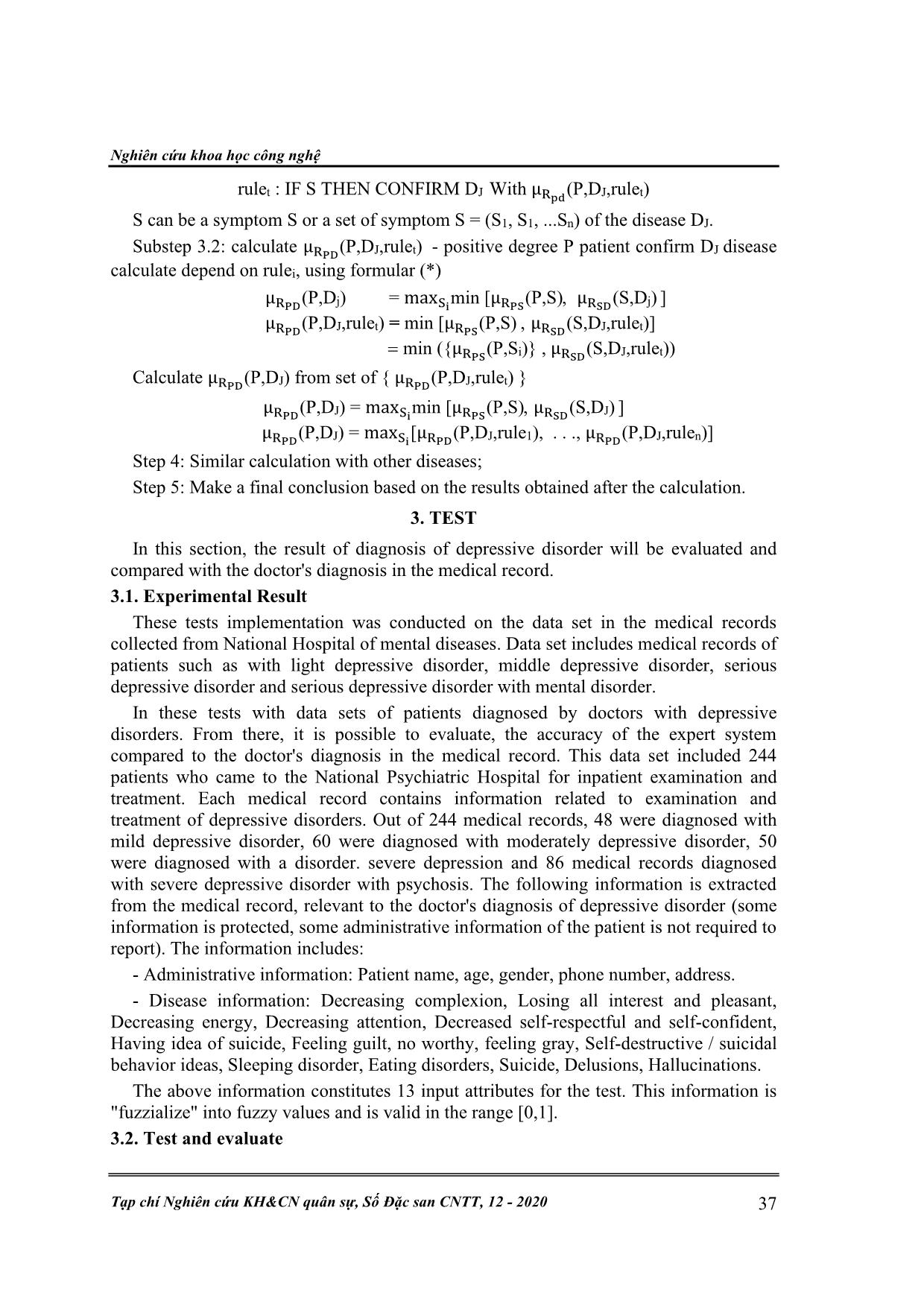
Trang 5
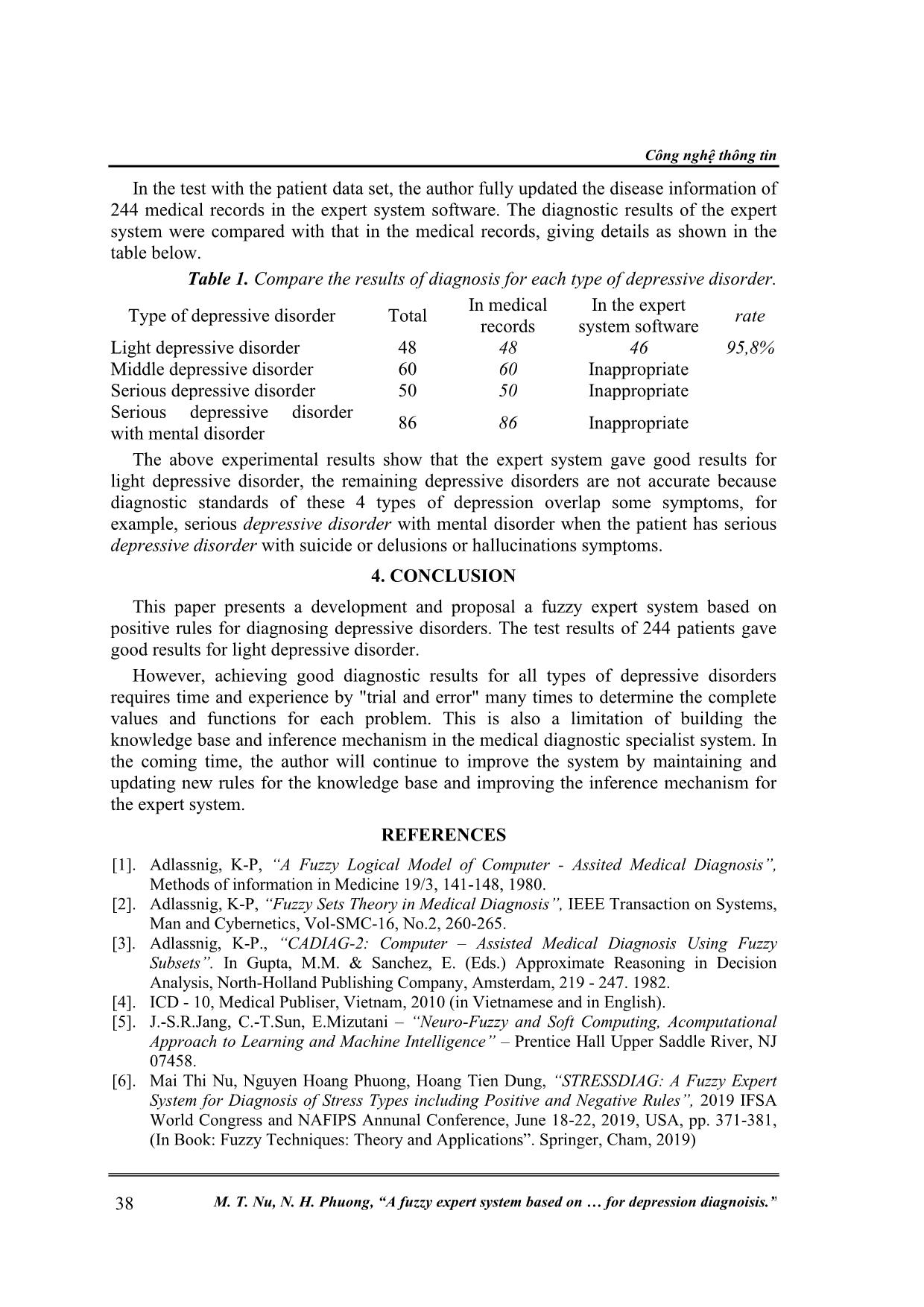
Trang 6
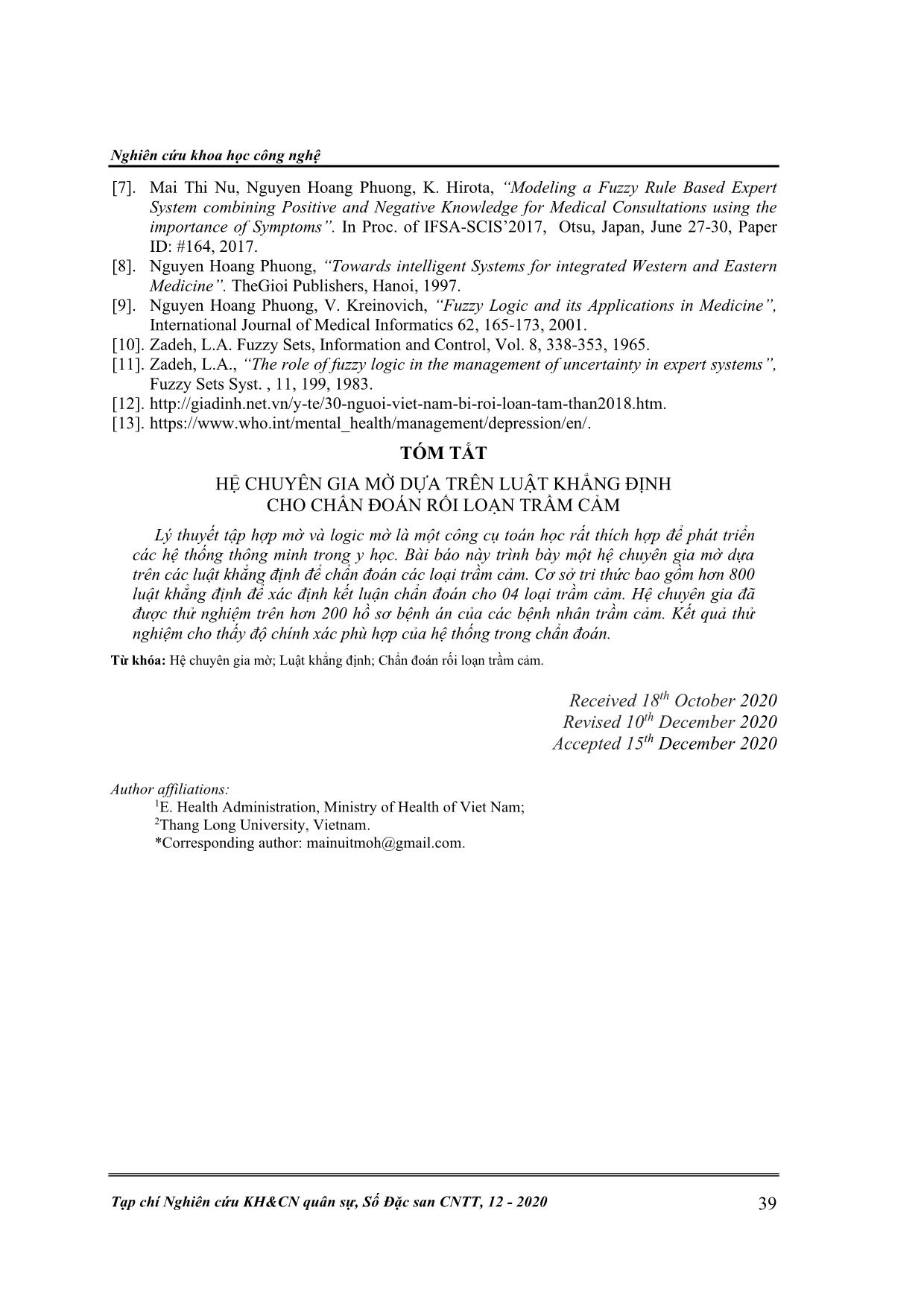
Trang 7
Bạn đang xem tài liệu "A fuzzy expert system based on positive rules for depression diagnoisis", để tải tài liệu gốc về máy hãy click vào nút Download ở trên
Tóm tắt nội dung tài liệu: A fuzzy expert system based on positive rules for depression diagnoisis
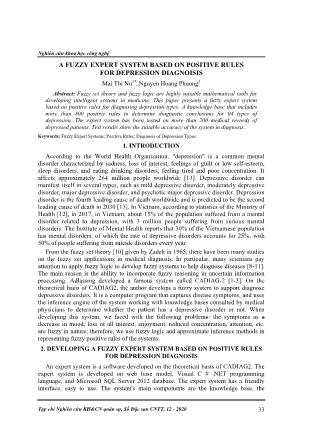
Nghiên cứu khoa học công nghệ
Tạp chí Nghiên cứu KH&CN quân sự, Số Đặc san CNTT, 12 - 2020 33
A FUZZY EXPERT SYSTEM BASED ON POSITIVE RULES
FOR DEPRESSION DIAGNOISIS
Mai Thi Nu1*, Nguyen Hoang Phuong2
Abstract: Fuzzy set theory and fuzzy logic are highly suitable mathematical tools for
developing intelligent systems in medicine. This paper presents a fuzzy expert system
based on positive rules for diagnosing depression types. A knowledge base that includes
more than 800 positive rules to determine diagnostic conclusions for 04 types of
depression. The expert system has been tested on more than 200 medical records of
depressed patients. Test results show the suitable accuracy of the system in diagnosis.
Keywords: Fuzzy Expert Systems; Positive Rules; Diagnosis of Depression Types.
1. INTRODUCTION
According to the World Health Organization, "depression" is a common mental
disorder characterized by sadness, loss of interest, feelings of guilt or low self-esteem,
sleep disorders, and eating drinking disorders, feeling tired and poor concentration. It
affects approximately 264 million people worldwide [13]. Depressive disorder can
manifest itself in several types, such as mild depressive disorder, moderately depressive
disorder, major depressive disorder, and psychotic major depressive disorder. Depression
disorder is the fourth leading cause of death worldwide and is predicted to be the second
leading cause of death in 2030 [13]. In Vietnam, according to statistics of the Ministry of
Health [12], in 2017, in Vietnam, about 15% of the population suffered from a mental
disorder related to depression, with 3 million people suffering from serious mental
disorders. The Institute of Mental Health reports that 30% of the Vietnamese population
has mental disorders, of which the rate of depressive disorders accounts for 25%, with
50% of people suffering from suicide disorders every year.
From the fuzzy set theory [10] given by Zadeh in 1965, there have been many studies
on the fuzzy set applications in medical diagnosis. In particular, many scientists pay
attention to apply fuzzy logic to develop fuzzy systems to help diagnose diseases [8-11].
The main reason is the ability to incorporate fuzzy reasoning in uncertain information
processing. Adlassnig developed a famous system called CADIAG-2 [1-3]. On the
theoretical basis of CADIAG2, the author develops a fuzzy system to support diagnose
depressive disorders. It is a computer program that captures disease symptoms, and uses
the inference engine of the system working with knowledge bases consulted by medical
physicians to determine whether the patient has a depressive disorder or not. When
developing this system, we faced with the following problems: the symptoms as a
decrease in mood, loss of all interest, enjoyment, reduced concentration, attention, etc.
are fuzzy in nature; therefore, we use fuzzy logic and approximate inference methods in
representing fuzzy positive rules of the systems.
2. DEVELOPING A FUZZY EXPERT SYSTEM BASED ON POSITIVE RULES
FOR DEPRESSION DIAGNOSIS
An expert system is a software developed on the theoretical basis of CADIAG2. The
expert system is developed on web base model, Visual C # .NET programming
language, and Microsoft SQL Server 2012 database. The expert system has a friendly
interface, easy to use. The system's main components are the knowledge base, the
Công nghệ thông tin
34 M. T. Nu, N. H. Phuong, “A fuzzy expert system based on for depression diagnoisis.”
inference mechanism, and a unit of explanation of diagnosis results described below.
The knowledge base is a part of the expert system, and the knowledge base contains
the knowledge of human experts. To have this knowledge, the knowledge engineer has
collected wisdom from human experts and then encoded it into the knowledge base
through the knowledge representation method. There are many methods to organize and
represent knowledge in computers; in this case, it chooses the method of knowledge
representation by the "IF-THEN" production rules with some fuzzy degree. This method
of representing knowledge effectively shows the fuzziness (uncertainty) in the knowledge
of doctors. This method also has many advantages in accordance with a decision support
model for diagnostics that is simple, easy to verify, easy to change, easy to modify, easy
to expand, and take advantage of the experience knowledge of medical doctors.
The (positive) rules of production take the following form:
IF (ASSUMPTION) THEN CONFIRM (CONCLUSION) WITH (FUZZY DEGREE)
Where
"ASSUMPTION" is a symptom or a combination of symptoms that are combined by
AND without using the NOT operator.
“CONCLUSION” is a depression type.
"FUZZY DEGREE" – a rule weight with the value in [0,1]. It indicates a degree of
belief of the rule when "ASSUMPTION" is satisfied, then “CONCLUSION” will be
confirmed.
To ensure accuracy, the rule set in the knowledge base must satisfy the principle:
there is not exist any two laws with the same premise and conclusion.
The knowledge base of the expert system contains 857 positive rules, which include:
124 rules for diagnosing light depressive disorder; 146 rules for diagnosing middle
depressive disorder, 263 rules for diagnosing serious depressive disorder and 324 rules
for diagnosing depressive disorder with mental disorder. The number of rules will
continue to increase as the system will be acquired knowledge from medical
professionals. Most of the rules have been consulted by health professionals. To form
these rules, the authors have listed all the clinical symptoms in patients diagnosed with
depressive disorders, there are 13 such symptoms, of which: there are 3 typical
symptoms, 7 universal symptoms, complications and 3 symptoms aggravate. The authors
haves sorted these symptoms according to their frequency of occurren ... d pleasant,
Decreasing energy, Decreasing attention, Decreased self-respectful and self-confident,
Having idea of suicide, Feeling guilt, no worthy, feeling gray, Self-destructive / suicidal
behavior ideas, Sleeping disorder, Eating disorders, Suicide, Delusions, Hallucinations.
Nghiên cứu khoa học công nghệ
Tạp chí Nghiên cứu KH&CN quân sự, Số Đặc san CNTT, 12 - 2020 35
Symptom Si take values μs, in [0,1]. The values μs, indicate the degree to which the
patient exhibits the symptom Si.
Intermediate combinations (fuzzy logical combinations of symptoms and diseases)
were introduced to the model of the pathophysiological states of patients; and Symptom
combinations 𝑆𝐶𝑖 are combinations of symptoms, diseases, and intermediate combinations.
Both entities take values 𝜇𝐼𝐶𝑘and 𝜇𝑆𝐶𝑖 (respectively) in [0,1]. A relationship 𝑅𝑃𝑆𝐶 is
established, defined by μRPSC(Pq, SCi) = 𝜇𝑆𝐶𝑖 for patient q where SCi = {𝑆𝐶1, , 𝑆𝐶𝑚}
formally describes the symptom combinations observed on the patient.
μRPCS(P,S) = min {μRPS1 (P,S1), μRPS2(P,S2), , μRPSi
(P,Si), μRSnP(P,Sn)}
Call D is the set of diseases, D = { D1, D2,. , Dm}, Di is the ith depressive disorder.
In our case, m=4, including: light depressive disorder, middle depressive disorder, serious
depressive disorder and serious depressive disorder with mental disorder.
A binary fuzzy relationship RPS is established, defined by μRPS(Pq, Si) = 𝜇𝑆𝑖 for
patient Pq, where Pq = {𝑃1, 𝑃𝑝} and Si ∈ {𝑆1, , 𝑆𝑚}. μRPS(Pq, Si) [0,1].
A symptom - diseases relationship RPD is established, defined by μRPD(Pq, Dj) = 𝜇𝐷𝑗
for patient 𝑃𝑝, where Dj = {𝐷1, 𝐷𝑛𝑝}
A fuzzy relationship RSD is established, defined by μRSD(S,DJ) [0,1]. This value
represents the degree of confidence in the likelihood of having or not having DJ disease
when a symptom or set of symptom S is present. Express the symptom-disease
relationship as the follow:
IF S THEN CONFIRM D WITH ( FUZZY DEGREE)
RSD is now a confirming relationship that the patient has DJ disease when there is a
symptom or set of S symptom S. The value μRSD(S,DJ) is fuzzy degree or rule weight.
- μRSD(S, DJ) = 1 means the elementary conjunction S of symptoms iS definitely
confirms the conclusion of DJ;
- μRSD(S, DJ) = 0 means the elementary conjunction S of symptoms iS definitely not
confirms the conclusion of jD ;
- 0 < μRSD(S, DJ)< 1 means the elementary conjunction.S of symptoms i
S confirms
the conclusion of jD with some fuzzy degree.
A fuzzy relationship RPD is established, defined by μRPD(P,DJ). Determining this
relationship also means making a diagnosis of the patient's likelihood. Based on these
fuzzy relationships, the MaxMin inference are used to deduce the fuzzy value
μRPD(Pq,DJ) which indicates the degree of confirmation of disease Dj suffered by patient
Pq from the observed symptoms. This MaxMin composition is the follow:
RPD = RPS o RSD
Where:
- RPS is symptom S relationship or combination S (S1, S1,...,Sn) appeared in patient P.
Công nghệ thông tin
36 M. T. Nu, N. H. Phuong, “A fuzzy expert system based on for depression diagnoisis.”
μRPD(P,DJ) = maxSimin [μRPS(P,S) μRSD (S,DJ) ] (*)
μRPD(P,DJ,rulet) = min [μRPS(P,S) μRSD(S,DJ,rulet)]
= min ({μRPS(Si,P)}, μRSD(S,DJ,rulet))
Where μRSD(S,DJ,rulet) is the degree of confirming DJ disease when there is an S
symptom or a set symptom S on the rulet (weight of rulet).
{ μRPD (P,DJ, rulet), , μRPD(P,DJ, rule1), , μRPD(P,DJ, rulen)} t = 1,..,n.
Calculate μRPD(P,DJ) from { μRPD(P,DJ,rulet) } according to the formula (*)
μRPD(P,DJ) = maxSimin [μRPS(P,S) μRSD(S,DJ) ]
μRPD(P,DJ) = maxSi [μRPD(P,DJ,rule1), . . ., μRPD(P,DJ,rulen)]
- μRpd(P, DJ) = 1 means absolutely confirm of conclusion of DJ;
- μRpd(P,DJ) = 0 means absolutely excludes of conclusion of DJ;
- 0 < μRpd(P,DJ) < 1 means confirms the conclusion of jD with some fuzzy degree.
The expert continues to acquire expert knowledge to complete the rules as well as
determine the accuracy of the found results, so the author will choose the above formula
with a high degree of confidence (accuracy). After acquiring expert knowledge, and
verifying through practice, the formula will be improved and changed.
Explain unit allows the program to explain its inference process to the user. These
explanations include the arguments that justify the system's conclusions (answer to the
how the system can gets the conclusion), explain why the system needs that data (the
answer to the why question), and so on.
To better understand the deductive process and diagnosis, The expert system can
explain how and why to reach a certain conclusion about the possibility of a patient with
a depressive disorder. During the diagnosis, the inference engine approves the rule and
marks all the matching rules. When the diagnosis is completed, the explanation is formed
by collecting all the satisfaction rules and step by step inference using each satisfaction
rule. In this explanation, the expert system shows the diagnostic results, all of the patient
symptom combinations used in the inference and the rules for individual patient
satisfaction. Thus, the user can see intermediate diagnostic conclusions from the steps of
the diagnostic process and how the rules affect the final conclusion.
Algorithm include 5 steps:
Input: list of symptom (confirmed symptoms appear in the patient after the
examination).
Step 1: Query the knowledge base, find all the rules for which the premise is a subset
of the set "List of input symptoms";
Step 2: Browse this rule set, group of rules that have the same conclusion DJ;
Step 3: Within each group of rules there is the same conclusion about DJ disease, with
the rules of DJ disease. For the set of rules of DJ disease = DJ = {rule1, rule2, rulei ,,
rulen), calculate μRPD(P,DJ) follows:
Substep 3.1: For each rulet of DJ disease:
Nghiên cứu khoa học công nghệ
Tạp chí Nghiên cứu KH&CN quân sự, Số Đặc san CNTT, 12 - 2020 37
rulet : IF S THEN CONFIRM DJ With μRpd(P,DJ,rulet)
S can be a symptom S or a set of symptom S = (S1, S1, ...Sn) of the disease DJ.
Substep 3.2: calculate μRPD(P,DJ,rulet) - positive degree P patient confirm DJ disease
calculate depend on rulei, using formular (*)
μRPD(P,Dj) = maxSimin [μRPS(P,S) μRSD(S,Dj) ]
μRPD(P,DJ,rulet) = min [μRPS(P,S) μRSD(S,DJ,rulet)]
= min ({μRPS(P,Si)} , μRSD(S,DJ,rulet))
Calculate μRPD(P,DJ) from set of { μRPD(P,DJ,rulet) }
μRPD(P,DJ) = maxSimin [μRPS(P,S) μRSD(S,DJ) ]
μRPD(P,DJ) = maxSi[μRPD(P,DJ,rule1), . . ., μRPD(P,DJ,rulen)]
Step 4: Similar calculation with other diseases;
Step 5: Make a final conclusion based on the results obtained after the calculation.
3. TEST
In this section, the result of diagnosis of depressive disorder will be evaluated and
compared with the doctor's diagnosis in the medical record.
3.1. Experimental Result
These tests implementation was conducted on the data set in the medical records
collected from National Hospital of mental diseases. Data set includes medical records of
patients such as with light depressive disorder, middle depressive disorder, serious
depressive disorder and serious depressive disorder with mental disorder.
In these tests with data sets of patients diagnosed by doctors with depressive
disorders. From there, it is possible to evaluate, the accuracy of the expert system
compared to the doctor's diagnosis in the medical record. This data set included 244
patients who came to the National Psychiatric Hospital for inpatient examination and
treatment. Each medical record contains information related to examination and
treatment of depressive disorders. Out of 244 medical records, 48 were diagnosed with
mild depressive disorder, 60 were diagnosed with moderately depressive disorder, 50
were diagnosed with a disorder. severe depression and 86 medical records diagnosed
with severe depressive disorder with psychosis. The following information is extracted
from the medical record, relevant to the doctor's diagnosis of depressive disorder (some
information is protected, some administrative information of the patient is not required to
report). The information includes:
- Administrative information: Patient name, age, gender, phone number, address.
- Disease information: Decreasing complexion, Losing all interest and pleasant,
Decreasing energy, Decreasing attention, Decreased self-respectful and self-confident,
Having idea of suicide, Feeling guilt, no worthy, feeling gray, Self-destructive / suicidal
behavior ideas, Sleeping disorder, Eating disorders, Suicide, Delusions, Hallucinations.
The above information constitutes 13 input attributes for the test. This information is
"fuzzialize" into fuzzy values and is valid in the range [0,1].
3.2. Test and evaluate
Công nghệ thông tin
38 M. T. Nu, N. H. Phuong, “A fuzzy expert system based on for depression diagnoisis.”
In the test with the patient data set, the author fully updated the disease information of
244 medical records in the expert system software. The diagnostic results of the expert
system were compared with that in the medical records, giving details as shown in the
table below.
Table 1. Compare the results of diagnosis for each type of depressive disorder.
Type of depressive disorder Total
In medical
records
In the expert
system software
rate
Light depressive disorder 48 48 46 95,8%
Middle depressive disorder 60 60 Inappropriate
Serious depressive disorder 50 50 Inappropriate
Serious depressive disorder
with mental disorder
86 86 Inappropriate
The above experimental results show that the expert system gave good results for
light depressive disorder, the remaining depressive disorders are not accurate because
diagnostic standards of these 4 types of depression overlap some symptoms, for
example, serious depressive disorder with mental disorder when the patient has serious
depressive disorder with suicide or delusions or hallucinations symptoms.
4. CONCLUSION
This paper presents a development and proposal a fuzzy expert system based on
positive rules for diagnosing depressive disorders. The test results of 244 patients gave
good results for light depressive disorder.
However, achieving good diagnostic results for all types of depressive disorders
requires time and experience by "trial and error" many times to determine the complete
values and functions for each problem. This is also a limitation of building the
knowledge base and inference mechanism in the medical diagnostic specialist system. In
the coming time, the author will continue to improve the system by maintaining and
updating new rules for the knowledge base and improving the inference mechanism for
the expert system.
REFERENCES
[1]. Adlassnig, K-P, “A Fuzzy Logical Model of Computer - Assited Medical Diagnosis”,
Methods of information in Medicine 19/3, 141-148, 1980.
[2]. Adlassnig, K-P, “Fuzzy Sets Theory in Medical Diagnosis”, IEEE Transaction on Systems,
Man and Cybernetics, Vol-SMC-16, No.2, 260-265.
[3]. Adlassnig, K-P., “CADIAG-2: Computer – Assisted Medical Diagnosis Using Fuzzy
Subsets”. In Gupta, M.M. & Sanchez, E. (Eds.) Approximate Reasoning in Decision
Analysis, North-Holland Publishing Company, Amsterdam, 219 - 247. 1982.
[4]. ICD - 10, Medical Publiser, Vietnam, 2010 (in Vietnamese and in English).
[5]. J.-S.R.Jang, C.-T.Sun, E.Mizutani – “Neuro-Fuzzy and Soft Computing, Acomputational
Approach to Learning and Machine Intelligence” – Prentice Hall Upper Saddle River, NJ
07458.
[6]. Mai Thi Nu, Nguyen Hoang Phuong, Hoang Tien Dung, “STRESSDIAG: A Fuzzy Expert
System for Diagnosis of Stress Types including Positive and Negative Rules”, 2019 IFSA
World Congress and NAFIPS Annunal Conference, June 18-22, 2019, USA, pp. 371-381,
(In Book: Fuzzy Techniques: Theory and Applications”. Springer, Cham, 2019)
Nghiên cứu khoa học công nghệ
Tạp chí Nghiên cứu KH&CN quân sự, Số Đặc san CNTT, 12 - 2020 39
[7]. Mai Thi Nu, Nguyen Hoang Phuong, K. Hirota, “Modeling a Fuzzy Rule Based Expert
System combining Positive and Negative Knowledge for Medical Consultations using the
importance of Symptoms”. In Proc. of IFSA-SCIS’2017, Otsu, Japan, June 27-30, Paper
ID: #164, 2017.
[8]. Nguyen Hoang Phuong, “Towards intelligent Systems for integrated Western and Eastern
Medicine”. TheGioi Publishers, Hanoi, 1997.
[9]. Nguyen Hoang Phuong, V. Kreinovich, “Fuzzy Logic and its Applications in Medicine”,
International Journal of Medical Informatics 62, 165-173, 2001.
[10]. Zadeh, L.A. Fuzzy Sets, Information and Control, Vol. 8, 338-353, 1965.
[11]. Zadeh, L.A., “The role of fuzzy logic in the management of uncertainty in expert systems”,
Fuzzy Sets Syst. , 11, 199, 1983.
[12].
[13]. https://www.who.int/mental_health/management/depression/en/.
TÓM TẮT
HỆ CHUYÊN GIA MỜ DỰA TRÊN LUẬT KHẲNG ĐỊNH
CHO CHẨN ĐOÁN RỐI LOẠN TRẦM CẢM
Lý thuyết tập hợp mờ và logic mờ là một công cụ toán học rất thích hợp để phát triển
các hệ thống thông minh trong y học. Bài báo này trình bày một hệ chuyên gia mờ dựa
trên các luật khẳng định để chẩn đoán các loại trầm cảm. Cơ sở tri thức bao gồm hơn 800
luật khẳng định để xác định kết luận chẩn đoán cho 04 loại trầm cảm. Hệ chuyên gia đã
được thử nghiệm trên hơn 200 hồ sơ bệnh án của các bệnh nhân trầm cảm. Kết quả thử
nghiệm cho thấy độ chính xác phù hợp của hệ thống trong chẩn đoán.
Từ khóa: Hệ chuyên gia mờ; Luật khẳng định; Chẩn đoán rối loạn trầm cảm.
Received 18th October 2020
Revised 10th December 2020
Accepted 15th December 2020
Author affiliations:
1E. Health Administration, Ministry of Health of Viet Nam;
2Thang Long University, Vietnam.
*Corresponding author: mainuitmoh@gmail.com.
File đính kèm:
 a_fuzzy_expert_system_based_on_positive_rules_for_depression.pdf
a_fuzzy_expert_system_based_on_positive_rules_for_depression.pdf

